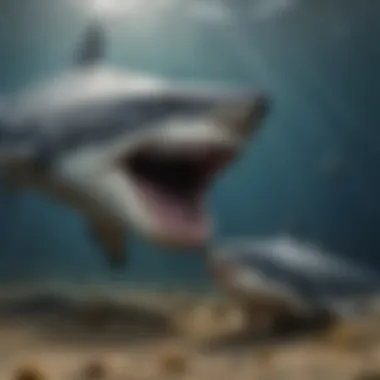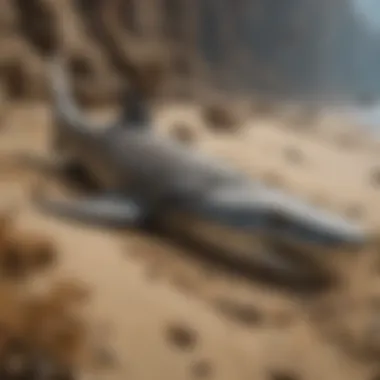Unveiling the Majestic Magnitude of the Megalodon Shark: A Prehistoric Giant


Rock and Fossil Identification
Collecting Tips and Techniques
Delving into the colossal realms of the megalodon shark necessitates adept collecting tips and techniques to navigate the intricacies of paleontological expeditions. Adopting best practices ensures the preservation of invaluable specimens, safeguarding delicate remnants of a bygone era. Locating prime collecting sites unveils untold stories hidden within the earth's embrace, teeming with fossils waiting to divulge their ancient secrets. Safely extracting specimens requires finesse and expertise, safeguarding these relics for future generations.
Preservation and Display
In the quest to preserve the enigmatic size of the megalodon shark for posterity, mastering preservation techniques is of paramount importance. Preserving rocks and fossils with precision and care safeguards these relics from the ravages of time, ensuring their longevity for scientific study and admiration. Adopting proper storage methods shields these treasures from deterioration, maintaining their pristine condition for generations to come. Exploring creative display ideas allows these ancient behemoths to captivate onlookers, transcending mere specimens to tangible links to our primordial past.
Geological Insights
Unearthing the enigmatic size of the megalodon shark unveils profound geological insights that offer a window into earth's tumultuous history. Delving into geological formations and processes unravels the intricate tapestry of earth's evolution, showcasing the transformative forces that shaped our planet. The historical significance of rocks and fossils enriches our understanding of past ecosystems, illuminating the interconnected web of life that spans millennia. Notable discoveries in the field continue to expand our knowledge, pushing the boundaries of paleontological research into uncharted territories.
Introduction
In the depths of prehistory lies a formidable creature that once roamed the ancient seas with unparalleled might and majesty - the megalodon shark. As we embark on a journey to unveil the enigmatic size of this oceanic titan, we immerse ourselves in a compelling narrative that transcends time and delves into the awe-inspiring dimensions of a predator like no other. The essence of this article is to meticulously dissect the sheer enormity of the megalodon, shedding light on its place in the pantheon of extinct giants that continue to captivate our imagination.
Exploring the Megalodon Shark
The exploration of the megalodon shark leads us down a path teeming with intrigue and wonder, where the behemoth's origins serve as a gateway to understanding its dominion over ancient waters.
Origins of the Megalodon
Deep within the annals of history, the origins of the megalodon emerge as a primeval enigma waiting to be deciphered. By unraveling the roots from which this colossal predator sprang forth, we gain insight into the evolutionary tapestry that shaped its reign as the apex predator of its time. The genetic intricacies that birthed the megalodon hold key evolutionary secrets, offering a glimpse into a bygone era of marine supremacy.
Significance in Paleontology
Within the realm of paleontology, the megalodon stands as a towering monolith of significance, casting a long shadow over the scientific landscape. Its colossal presence in fossil records serves as a testament to the grandeur of prehistoric megafauna, providing researchers with a treasure trove of data to unravel the mysteries of ancient maritime ecosystems. The profound significance of the megalodon in paleontological studies transcends mere fascination, offering valuable insights into the dynamics of predator-prey relationships in primeval oceans.


Purpose of the Study
Understanding Megalodon's Size
Central to our study is the pursuit of understanding the sheer magnitude of the megalodon's size - a Herculean task that requires precision and meticulous analysis. By dissecting every aspect of its dimensions, from tooth to tail, we aim to paint a vivid portrait of a colossus that once ruled the seas, offering a glimpse into the biomechanical marvel that propelled this ancient leviathan through the depths.
Implications of its Massive Dimensions
The implications of the megalodon's massive dimensions extend far beyond mere numbers, carrying profound implications for our understanding of ancient marine ecosystems. By examining the repercussions of its immense size on prey dynamics, predatory strategies, and ecological niches, we unravel a tapestry of interconnected truths that highlight the vital role this gigantic predator played in shaping the evolutionary landscape of the oceans. Exploring the ripple effects of its size opens a window into a world where giants roamed freely, leaving an indelible mark on the annals of natural history.
Prehistoric Giant
The section on Prehistoric Giant plunges us into the fascinating world of the megalodon shark, a colossal creature that once ruled the ancient seas with unmatched dominance. In this part of the article, we will dissect the immense size and distinctive features of this prehistoric giant, shedding light on its significance in the realm of paleontology. By delving deep into the origins of the megalodon and its unparalleled importance in the evolutionary timeline, we aim to unearth the mysteries that shroud this enigmatic predator in the depths of history.
Megalodon Anatomy
Teeth Size
In the realm of Megalodon Anatomy, the aspect of Teeth Size commands attention due to its pivotal role in the predatory prowess of this ancient shark. The gigantic teeth of the megalodon are a testament to its formidable presence in prehistoric oceans. These serrated, triangular teeth resemble imposing daggers, perfectly adapted for slicing through flesh with unparalleled efficiency. The unique feature of Teeth Size lies in its sheer magnitude, with specimens reaching sizes that dwarf those of contemporary shark species. While beneficial for preying on large marine mammals, such as whales, the intimidating Teeth Size of the megalodon also posed challenges in terms of energy consumption and wear and tear.
Jaw Strength
Another essential component of Megalodon Anatomy is its Jaw Strength, a characteristic that underlined the predatory tactics of this ancient behemoth. The immense power and crushing capability of the megalodon's jaws were unparalleled in the prehistoric seas. By exerting tremendous bite force, the megalodon could easily pulverize bones and shells, devouring its prey with unparalleled ferocity. The unique feature of Jaw Strength stemmed from the robust anatomy of the megalodon's cranial structure, enabling it to maintain an iron grip on struggling prey. While advantageous for asserting dominance as a top predator, the reliance on such intense Jaw Strength also necessitated regular dental replacements to accommodate the wear caused by constant feeding frenzies.
Comparative Analysis
Size Comparison with Modern Sharks
Undertaking a Comparative Analysis between the megalodon and modern sharks unveils intriguing insights into the evolution of these apex predators. By juxtaposing the gargantuan size of the megalodon with the more modest proportions of contemporary shark species, the stark contrasts in predatory strategies and ecological niches come to the forefront. The key characteristic of Size Comparison with Modern Sharks lies in the evolutionary adaptability that enabled modern sharks to thrive in diverse marine habitats, contrasting with the specialized hunting techniques of the megalodon. While the megalodon's immense size conferred unparalleled dominance, it also restricted its agility and versatility, traits that modern sharks have capitalized on to navigate rapidly changing oceanic environments.


Ecological Role
Exploring the Ecological Role of the megalodon is crucial to understanding its impact on prehistoric ecosystems. As a top predator of its time, the megalodon wielded immense influence over marine food webs, regulating prey populations and shaping community dynamics. The key characteristic of Ecological Role lies in the cascading effects of the megalodon's presence on lower trophic levels, exerting selective pressures that influenced the evolution of various marine species. While beneficial for maintaining a semblance of ecological balance, the extinction of the megalodon created vacuums in apex predator positions, leading to cascading effects on marine biodiversity. By unraveling the intricate web of interactions orchestrated by the megalodon, we can glean valuable insights into the complexities of ancient marine ecosystems.
Size Matters
The concept of size in the realm of the megalodon shark encapsulates a myriad of significant facets vital for comprehending the enigmatic nature of this ancient behemoth. Delving into the sheer enormity of the megalodon entails not just numerical values but a deeper understanding of evolutionary implications, ecological dynamics, and predatory strategies unique to this apex predator. Unveiling the enigmatic size of the megalodon is inherently intertwined with unlocking the secrets of its dominance in prehistoric oceans, shedding light on a creature that continues to intrigue and astonish modern-day enthusiasts.
Length and Weight
Estimations and Calculations
In the meticulous study of the megalodon's proportions, the realm of estimations and calculations emerges as a crucial linchpin in unraveling the mysteries of its size. By employing a blend of scientific methodologies, researchers delve into historical data, fossil records, and comparative analyses to extrapolate the dimensions of this prehistoric giant. The meticulous nature of these calculations provides a window into the past, allowing us to visualize the immense lengths and weights that the megalodon once commanded. Despite inherent challenges and uncertainties in reconstructing a creature long extinct, the process of estimations and calculations serves as a cornerstone in piecing together the puzzle of the megalodon's formidable size.
Largest Specimens Found
Within the annals of paleontology, the discoveries of the largest megalodon specimens stand as pivotal milestones in understanding the scope of this ancient predator. Unearthing fossil remains that speak to the sheer magnitude of these creatures offers tangible evidence of their existence and size. Through careful examination of these specimens, scientists gain insights into not just the physical dimensions but also the behavioral patterns and ecological niches occupied by the megalodon. The significance of the largest specimens found lies not only in their imposing size but in the narratives they weave about a bygone era dominated by these colossal sharks, enriching our understanding of their place in prehistoric ecosystems.
Girth and Massiveness
Body Diameter
Exploring the body diameter of the megalodon unveils a dimension of its size that goes beyond mere length, offering a holistic perspective on its massiveness. The sheer girth of the megalodon's body held implications for its swimming prowess, buoyancy control, and overall anatomical structure. Understanding the body diameter entails not just visualizing a number but appreciating the biomechanical adaptations required to support such colossal proportions. From jaw muscle attachment points to swimming efficiency, the body diameter of the megalodon provides a window into its evolutionary journey and the biological marvel that allowed this giant shark to thrive.
Weight Distribution
The distribution of weight across the megalodon's massive frame held critical importance in shaping its predatory strategies and ecological role. From the skeletal structure to soft tissue distribution, the mass distribution of the megalodon influenced everything from buoyancy control to maneuverability in the marine environment. Unraveling how this weight was distributed offers insights into the swimming capabilities, hunting prowess, and energy requirements of this apex predator. By dissecting the nuances of weight distribution, we gain a deeper appreciation for the biomechanical intricacies that underpinned the formidable presence of the megalodon in prehistoric oceans.
Impacts of Megalodon's Size


When delving into the massive dimensions of the megalodon shark, it is crucial to understand the profound impacts its size had on the prehistoric ecosystem. The sheer bulk and prowess of this apex predator reverberated throughout the ancient oceans, shaping the dynamics of the marine world in ways unparalleled. By dissecting the ecological influence, evolutionary adaptations, and legacy of the megalodon, we gain valuable insights into the interplay of size and survival in a bygone era.
Ecological Influence
Top Predator Dynamics
The top predator dynamics within the realm of the megalodon elucidate the hierarchical structure of ancient marine ecosystems. As the ultimate apex predator, the megalodon dictated the balance of power, exerting its dominance over lesser species. The strategic positioning as the paramount hunter allowed the megalodon to regulate population sizes of other marine creatures, ensuring ecological stability through its predatory prowess. This facet of top predator dynamics underscores the essential role that these colossal sharks played in sculpting the evolutionary trajectories of countless marine species, showcasing the intricate interdependencies within prehistoric food webs.
Prey Interactions
Examining the prey interactions of the megalodon unveils a complex tapestry of survival strategies and evolutionary adaptations. The seamless interaction between predator and prey reflected a delicate dance of life and death in the ancient oceans. The megalodon's size and hunting techniques were finely tuned to target specific marine species, illustrating a sophisticated approach to sustaining its massive body mass. This section delves into the nuanced intricacies of how the megalodon's feeding habits influenced the evolutionary paths of both predator and prey, shedding light on the profound consequences of size differentials in shaping the dynamics of ancient marine communities.
Evolutionary Adaptations
Survival Strategies
The megalodon's survival strategies were honed through millions of years of evolution, enabling it to thrive as a top predator of the prehistoric oceans. From its remarkable sensory adaptations to its colossal body size, every aspect of the megalodon's physiology was finely tuned for survival in the brutal marine environment. By dissecting these survival strategies, we unravel the evolutionary arms race that molded the megalodon into an unparalleled marine titan.
Hunting Techniques
The hunting techniques employed by the megalodon were a testament to its efficient predatory adaptations. From stealthy approaches to swift strikes, the megalodon showcased a diverse array of hunting tactics tailored to capture prey with maximum efficacy. This section scrutinizes the anatomy and behavior of the megalodon during hunts, shedding light on the sophisticated strategies that enabled this ancient behemoth to reign as the apex predator of the seas.
Legacy of the Megalodon
In the vast tapestry of prehistoric marine creatures, the legacy of the Megalodon stands as a testament to sheer magnitude and evolutionary prowess. This section delves into the enduring impact of this extraordinary predator, resonating across time and infusing modern consciousness with intrigue and reverence. The Megalodon, with its unparalleled size and unparalleled dominance, continues to fascinate scholars, enthusiasts, and popular culture creators alike.
Modern Reverberations
Pop Culture Influence
The realm of pop culture has undeniably been under the spell of the Megalodon's colossal presence. From blockbuster movies to captivating documentaries, the Pop Culture Influence of this prehistoric leviathan has transcended generations. Its gigantic silhouette and formidable reputation have been expertly woven into the fabric of entertainment, sparking curiosity and awe among audiences worldwide. While some may argue that its portrayal is embellished for dramatic effect, there is no denying the allure and excitement it brings to the table.
Scientific Fascination
Nestled within the scientific community lies a profound fascination with the Megalodon, serving as a gateway to unraveling mysteries of the ancient oceans. The Scientific Fascination surrounding this apex predator stems from its pivotal role in shaping marine ecosystems and evolutionary dynamics. Through meticulously curated research and exploration, scientists continue to uncover new revelations about the Megalodon's behavior, anatomy, and ecological impact. This fascination extends beyond academic circles, captivating the imaginations of individuals eager to comprehend the complexities of prehistoric life.







